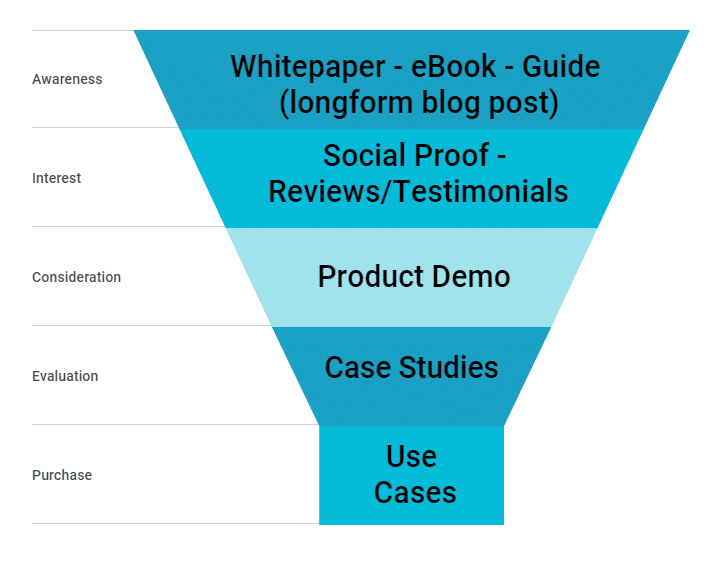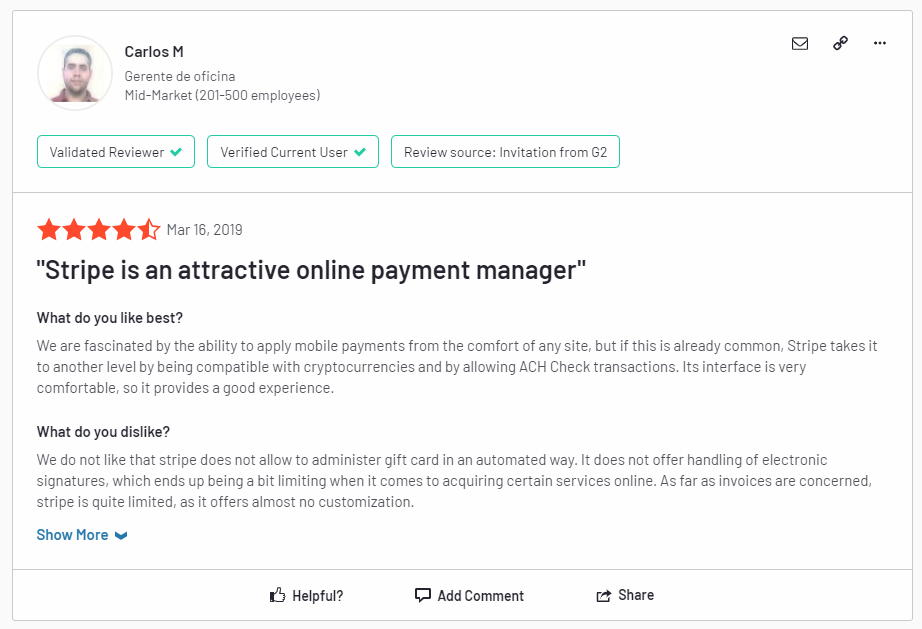Five Content Pieces You Need to Market Your SaaS Tool Effectively

Creating high quality content can be an overwhelming process. There are many moving parts involved, particularly for SaaS companies that sell complex solutions to sales groups that may contain upwards of ten or more people. One of the best ways to assess and act on your content needs is to create a content strategy, a process that we outlined specifically for SaaS companies in a recent blog post.
Another way to address content needs without overwhelming your resources is to focus on developing a few key pieces of content, each of which serves a distinct purpose. Although the content you create will be unique to your business and audience, some content is universally helpful. In this post, we’ll review five key pieces of content that SaaS companies can create and incorporate into an effective content marketing strategy.
They include, in order of their position within the sales funnel (from top to bottom):
- Whitepaper/eBook/Guide
- Social proof – reviews/testimonials
- Product demo
- Case studies
- Use cases
Here’s how that looks within a basic sales funnel:

While each piece of content is focused on a specific part of the above funnel, most of these content pieces can be repurposed effectively depending on your needs.
#1: Whitepaper—eBook—Guide
Longform content such as whitepapers, eBooks, and how-to guides are helpful when buyers are in the early, top-of-funnel discovery phase (e.g., awareness & interest). You don’t need to create an exhaustive library of whitepapers. In fact, one or two succinct pieces of roughly 1500 to 2000 words is a good place to start, particularly when you consider that 93% of B2B marketers that responded to DemandGen’s 2019 Content Preferences Survey Report, noted that they prefer shorter content formats.
When creating a longform piece of content like a whitepaper or eBook, keep in mind that B2B buyers place a strong emphasis on the trustworthiness of the source of the material. For longer content, third part/analyst reports, case studies and industry newsletters all ranked as top sources for buyers in the DemandGen report (all these things can be turned into whitepapers).
When creating a white paper, it’s important to source all statistics and provide very clear context about why you’re the expert in your chosen topic. It can also help to partner with a third-party research company (if market research is involved), because this provides credibility while eliminating some perceived bias for prospects. Another tip based on DemandGen’s survey results: organize your content by issue/pain point. Companies seek out new solutions so they can solve a problem—make sure you address what key problems your product, service, or company solve.
#2: Social Proof—Reviews—Testimonials
92% of respondents in the DemandGen survey indicated they give the most credence to peer reviews and user-generated feedback. This type of content provides social proof—it lends credibility to your company, product, or service. Fully 97% of DemandGen’s respondents indicated they place a higher emphasis on the source of the content they read (up from 78% in 2018).
Industry influencers play a significant role in content that provides social proof—CEOs, CMOs, bloggers, and luminaries such as Rand Fishkin the founder of Moz, and the current CEO and founder of SparkToro can lend credibility to your brand by endorsing it or writing about it. Likewise, your clients can either write content or contribute to the content you develop by providing quotes, testimonials and data for case studies.
User generated content in the form of testimonials and reviews on third-party websites such as G2 Crowd and Capterra can help demonstrate social proof. Again, your clients are your best resource for obtaining this content. Once a testimonial or review has been written, you can repurpose it by publishing it on your website and sharing it on social media.

A user review of payment gateway Stripe on G2 Crowd
#3: Product Demo
Product demos typically come into play further along the sales funnel, when a prospect is ready to speak with a sales rep. We recently published a guide outlining how SaaS companies can supercharge demo requests, but obviously the sales demo itself must be created before you can leverage demo requests as a lead generation tool. A demo can be a powerful selling tool, particularly for SaaS companies who want to stand out in a cluttered marketplace.
Sales demos should be informative and interesting—don’t overwhelm your prospects with too much detail or information. Spend time understanding the content preferences of your specific audience and make sure your sales team is comfortable hosting a demo. Nearly 60% of B2B prospects aren’t satisfied with the preparation of the sales team, so working with sales to create an effective demo that they’re comfortable with is important.
If possible, incorporate video into your product demo since consumers are much more likely to buy a product or service after watching a video. It can also be a lot easier to communicate a complex technology or concept via video than with slides and text.
The demo is a key inbound marketing tool which can help move your prospects further along in the sales funnel, but it also has the power to confuse prospects or kill the momentum. Thus, spending time ensuring that your demo is informative, helpful and of the highest quality is just as important as creating the demo in the first place.
#4: Case Studies
It’s not hyperbole to say that a good case study is one of the most important pieces of content that you can create. Per DemandGen, case studies and webinars are the top influencer content choices of B2B marketers, with 47% of respondents in their 2019 content survey opting to review case studies from companies that are experiencing similar pain points as they are, and 39% indicating webinars were a valuable source of information.
In addition to providing social proof and helping establish credibility, case studies are innately shareable across buying teams and help tamp down the “sales speak” which is inherently a part of product demos and webinars.
Case studies that incorporate visual, audio, and graphical elements are much more likely to appeal to buyers than static, text-heavy content. In the DemandGen survey, 51% of respondents indicated they’re willing to spend five to 20 minutes watching a video, and 58% were willing to spend the same amount of time reviewing interactive content, while half of respondents are willing to spend 10 to 30 minutes listening to podcasts. The point here is, be creative with how you present your case studies and make them eminently shareable.
#5: Use Cases
Last, but certainly not least, is the development of relevant use cases. Uses cases help demonstrate how your product, service, or company can help solve a specific problem. This is very targeted, end-of-funnel content that can help a prospect feel confident that your solution is the exact tool they need.
Use cases can be rolled into other content types such as product demos, webinars, and whitepapers, or act as stand-alone content aimed at demonstrating the value of your solution to a specific target persona.
Use cases can also help illustrate how best to deploy your software, particularly if you have a variety of different services, licenses, and products. To this end, the use case can become a tangible model that buying groups can use to justify the purchase of your particular solution, and help them understand, in a practical sense, how a given tool can best be utilized within their organization.
Content is king (within reason)
Content is personal. The specific content pieces you create are highly contingent on your industry, solution, and audience. Thus, creating all five types of content may be right for some companies while only a few pieces from the above list may be appropriate for others.
Regardless of what you decide to create, focusing on a few key pieces of (high quality) content and ensuring that each piece of content has a clear purpose is an effective way to manage your content needs and ensure that you’re delivering the most relevant content to prospects and clients at the most relevant time on their buying journey.
***
Contact us to learn more about creating a comprehensive B2B content strategy. We’re happy to provide a free 30-minute consultation.
Share this
You May Also Like
These Related Stories

AI In Content Marketing - What You Need to Know

Five Types of Digital Marketing to Help You Plan Your Digital Strategy
